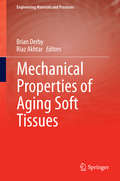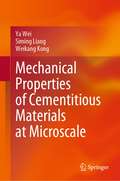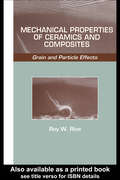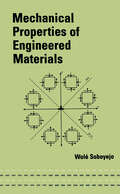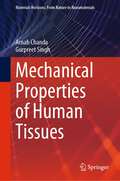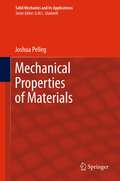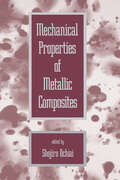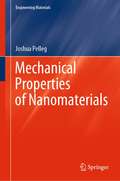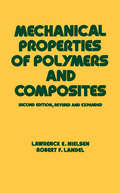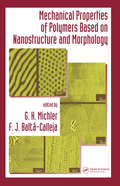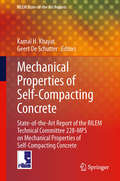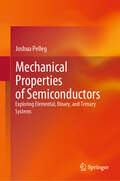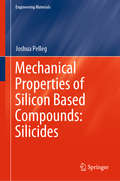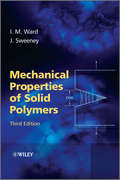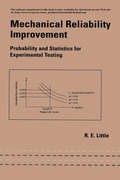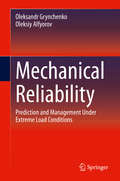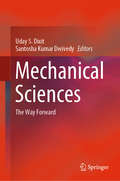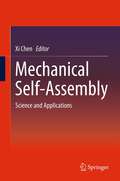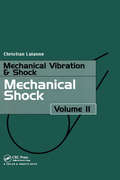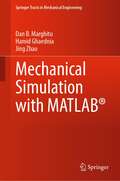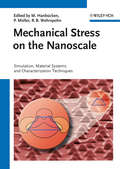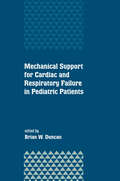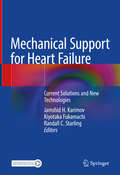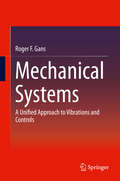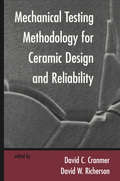- Table View
- List View
Mechanical Properties of Aging Soft Tissues
by Brian Derby Riaz AkhtarExploring the structure and mechanics of aging soft tissues, this edited volume presents authoritative reviews from leading experts on a range of tissues including skin, tendons, vasculature and plantar soft tissues. It provides an overview of in vivo and in vitro measurement techniques including state-of-the-art methodologies, as well as focusing on the structural changes that occur within the main components of these tissues resulting in detrimental mechanical property changes. It also highlights the current challenges of this field, and offers an insight into future developments. Age-related changes in the mechanical properties of soft tissues have a profound effect on human morbidity and mortality, and with changing global demographics, there is growing interest in this area. There has been increasing interest in robustly characterizing these mechanical changes to develop structure-property relationships, and growing awareness of the need for enhanced predictive models for computational simulations. This book seeks to address the challenges involved in applying these engineering techniques to reliably characterize these tissues. Focusing on a wide range of tissues and presenting cutting-edge techniques, this book provides an invaluable reference to academics and researchers in a range of disciplines including biomechanics, materials science, tissue engineering, life sciences and biomedicine.
Mechanical Properties of Cementitious Materials at Microscale
by Ya Wei Siming Liang Weikang KongThis book provides information on characterizing the microstructure and mechanical properties of cementitious materials at microscale. Specifically, with the intention to provide the methods of preparing the samples for the micro-scale mechanical testing, to address the techniques for measuring and analyzing the elastic modulus, the stiffness, and the fracture toughness of cementitious materials at micro scale by instrumented indentation, to describe a method for measuring and interpreting creep behavior of cementitious materials at micro scale, and to demonstrate the homogenization method for obtaining the mechanical properties of cementitious materials across scales. The information in this book is helpful to a wide readership in the field of civil engineering and materials science working with cementitious materials and other composite materials.
Mechanical Properties of Ceramics and Composites: Grain And Particle Effects
by Roy W. RiceThis book presents a comprehensive review, evaluation, and summary of the dependence of mechanical properties on grain and particle parameters of monolithic ceramics and ceramic composites. Emphasizing the critical link between fabrication and ceramic performance, the book covers the grain dependence of monolithic properties and the dependence of c
Mechanical Properties of Engineered Materials
by Wole SoboyejoFeaturing in-depth discussions on tensile and compressive properties, shear properties, strength, hardness, environmental effects, and creep crack growth, "Mechanical Properties of Engineered Materials" considers computation of principal stresses and strains, mechanical testing, plasticity in ceramics, metals, intermetallics, and polymers, materials selection for thermal shock resistance, the analysis of failure mechanisms such as fatigue, fracture, and creep, and fatigue life prediction. It is a top-shelf reference for professionals and students in materials, chemical, mechanical, corrosion, industrial, civil, and maintenance engineering; and surface chemistry.
Mechanical Properties of Human Tissues (Materials Horizons: From Nature to Nanomaterials)
by Gurpreet Singh Arnab ChandaThis monograph brings forth biomechanical research methods and outcomes on human tissue experiments such as those of the brain and the heart under a single umbrella. Different mechanical characterization techniques employed in human tissue property estimation are presented in detail. The contents also focus on a hyperelastic constitutive model (e.g., Mooney-Rivlin, Ogden) for both isotropic and anisotropic tissue characterization. It also discusses energy dissipation in soft tissues and associated viscoelasticity. Human tissues, including skin, muscles, connective tissues, and tissues in all functional organs are listed and their mechanical properties are presented in detail. These tissue properties are indispensable for computational modeling of biological systems, validation of biomechanical tissue testing, medical simulation through development of artificial phantoms and surrogates, and testing of medical devices and interventions. This book will serve as a key reference for research in tissue engineering & biomedical engineering, medical simulation, biomechanics, finite element modeling of biological systems, biomaterials, biotechnology, implant and medical device development, and healthcare wearables.
Mechanical Properties of Materials
by Joshua PellegThe subject of mechanical behavior has been in the front line of basic studies in engineering curricula for many years. This textbook was written for engineering students with the aim of presenting, in a relatively simple manner, the basic concepts of mechanical behavior in solid materials. A second aim of the book is to guide students in their laboratory experiments by helping them to understand their observations in parallel with the lectures of their various courses; therefore the first chapter of the book is devoted to mechanical testing. Another aim of the book is to provide practicing engineers with basic help to bridge the gap of time that has passed from their graduation up to their actual involvement in engineering work. The book also serves as the basis for more advanced studies and seminars when pursuing courses on a graduate level. The content of this textbook and the topics discussed correspond to courses that are usually taught in universities and colleges all over the world, but with a different and more modern approach. It is however unique by the inclusion of an extensive chapter on mechanical behavior in the micron and submicron/nanometer range. Mechanical deformation phenomena are explained and often related to the presence of dislocations in structures. Many practical illustrations are provided representing various observations encountered in actual structures of particularly technical significance. A comprehensive list of references at the end of each chapter is included to provide a broad basis for further studying the subject.
Mechanical Properties of Metallic Composites (Materials Engineering)
by Shojiro OchiaiProvides coverage of dispersion-hardened and fibre-reinforced alloys, addressing principal mechanisms, processing and applications. Mechanical behaviour based on dislocation theory and elastic-plastic mechanics is dealt with and data on advanced composites are provided.
Mechanical Properties of Nanomaterials (Engineering Materials)
by Joshua PellegThis book highlights the mechanical properties of nanomaterials produced by several techniques for various applications. The dislocations observed in specimens obtained in nanomaterials are discussed on the chapter about deformation process. Partial dislocations and grain boundary sliding deformation phenomena in nanomaterial specimens are also deeply discussed. Tests for tension, compression, and hardness are described. The behavior of nanomaterials is compared to macrosize specimens, and the results obtained for different fabrication methods are also compared. The special characteristics of nanomaterials are summarized at the end of the book.
Mechanical Properties of Polymers and Composites (Mechanical Engineering)
by Robert F. Landel Lawrence E. NielsenThis text, now in its second edition, offers an up-to-date, expanded treatment of the behaviour of polymers with regard to material variables and test and use conditions. It highlights general principles, useful empirical rules and practical equations.;Detailing the specific behaviour of many common polymers, the text: places emphasis on time and frequency dependence over temperature dependence; uses contemporary molecular mechanisms to explain creep, stress relaxation, constant strain rate responses and crazing; provides explicit equations to predict responses; supplies a discussion of large deformation multiaxial responses; compares statistical and continuum theories on the same data set; and updates stress-strain behaviour and particulate filled systems.
Mechanical Properties of Polymers based on Nanostructure and Morphology
by G. H. Michler F. J. Baltá-CallejaThe improvement of strength and durability in polymers has implications relevant to industrial, medical, and household applications. Enhanced by the improved knowledge of the interactions between complex hierarchical structures and functional requirements, Mechanical Properties of Polymers Based on Nanostructure and Morphology focuses on new polyme
Mechanical Properties of Self-Compacting Concrete
by Kamal H. Khayat Geert De SchutterThe State-of-the-Art Report of RILEM Technical Committee 228-MPS on Mechanical properties of Self-Compacting Concrete (SCC) summarizes an extensive body of information related to mechanical properties and mechanical behaviour of SCC. Due attention is given to the fact that the composition of SCC varies significantly. A wide range of mechanical properties are considered, including compressive strength, stress-strain relationship, tensile and flexural strengths, modulus of elasticity, shear strength, effect of elevated temperature, such as fire spalling and residual properties after fire, in-situ properties, creep, shrinkage, bond properties and structural behaviour. A chapter on fibre-reinforced SCC is included, as well as a chapter on specialty SCC, such as light-weight SCC, heavy-weight SCC, preplaced aggregate SCC, special fibre reinforced SCC and underwater concrete.
Mechanical Properties of Semiconductors: Exploring Elemental, Binary, and Ternary Systems
by Joshua PellegThis book is a comprehensive guide to understanding the mechanical behavior of specific semiconductors: Elemental Semiconductors: Si, Ge; Binary Semiconductors: SiC, GaAs, GaP, InP; Ternary Semiconductors: AlGaAs, GaAsP, ZnCdTe . The chapters are arranged in a logical sequence, starting with the basics of semiconductors in Chapter 1 and gradually progressing to more complex topics. Chapter 2 delves into the elastic properties and yielding concept, while Chapter 3 discusses plastic deformation and its relation to semiconductor stability. The important role of defects in semiconductors is explored in Chapter 4, with a focus on point defects and dislocations.Chapter 5 covers static deformation, including hardness and brittle behavior, while Chapter 6 explains the phenomenon of work hardening and its relationship to dislocations in the material. Chapter 7 introduces time-dependent deformation, specifically creep, which is influenced by temperature. Fracture, a common mode of failure in semiconductors, is discussed in Chapter 8, with an emphasis on stress rupture and the inability to carry an applied load. Chapter 9 addresses the unique mechanical behavior of small size semiconductor specimens in the nano scale. Finally, Chapter 10 explores the environmental effects on the mechanical properties of semiconductors. Overall, this book provides a comprehensive and detailed understanding of the mechanical behavior of some elemental, binary and ternary semiconductors, which is crucial for developing and designing semiconductor-based technologies.
Mechanical Properties of Silicon Based Compounds: Silicides (Engineering Materials)
by Joshua PellegThis book focuses on the mechanical properties of silicides for very large scale integration (VLSI) applications. It presents the fabrication process for bulk silicides and thin films, and list complete testing deformation for a variety of silicon based compounds. The author also presents dislocation in silicides, fatigue and fracture aspects. A special chapter is given on deformation in silicides in the nano scale. Composites and alloys are also considered.
Mechanical Properties of Solid Polymers
by I. M. Ward J. SweeneyProviding an updated and comprehensive account of the properties of solid polymers, the book covers all aspects of mechanical behaviour. This includes finite elastic behavior, linear viscoelasticity and mechanical relaxations, mechanical anisotropy, non-linear viscoelasicity, yield behavior and fracture. New to this edition is coverage of polymer nanocomposites, and molecular interpretations of yield, e. g. Bowden, Young, and Argon. The book begins by focusing on the structure of polymers, including their chemical composition and physical structure. It goes on to discuss the mechanical properties and behaviour of polymers, the statistical molecular theories of the rubber-like state and describes aspects of linear viscoelastic behaviour, its measurement, and experimental studies. Later chapters cover composites and experimental behaviour, relaxation transitions, stress and yielding. The book concludes with a discussion of breaking phenomena.
Mechanical Reliability Improvement: Probability and Statistics for Experimental Testing
by Robert LittleProviding probability and statistical concepts developed using pseudorandom numbers, this book covers enumeration-, simulation-, and randomization-based statistical analyses for comparison of the test performance of alternative designs, as well as simulation- and randomization-based tests for examination of the credibility of statistical presumptions. The book discusses centroid and moment of inertia analogies for mean and variance and the organization structure of completely randomized, randomized complete block, and split spot experiment test programs. Purchase of the text provides access to 200 microcomputer programs illustrating a wide range of reliability and statistical analyses.
Mechanical Reliability: Prediction and Management Under Extreme Load Conditions
by Oleksandr Grynchenko Oleksiy AlfyorovThe volume describes the main theoretical propositions of the methodology to predict mechanical reliability under conditions of repeated exposure to random extreme loads. The mechanical load process is considered to be a form of a discrete sequence of loads occurring at times that form a random flow. The authors present solved problems of reliability prediction of elements having deterministic or random bearing capacity. A method for the probabilistic justification of safety factors is also developed in the book, providing a predetermined level of reliability of elements and systems for sudden failures during design. It considers the methods of prediction and managing reliability under conditions of using safety devices. The main theoretical results are presented in a form available for practical engineering applications. The book can be used by researchers and as a manual by teachers and graduate students of higher technical educational institutions.
Mechanical Sciences: The Way Forward
by Uday S. Dixit Santosha Kumar DwivedyThis book consists of review articles by experts on recent developments in mechanical engineering sciences. The book has been composed to commemorate the Silver Jubilee of the Mechanical Engineering Department, Indian Institute of Technology Guwahati. It includes articles on modern mechanical sciences subjects of advanced simulation techniques and molecular dynamics, microfluidics and microfluidic devices, energy systems, intelligent fabrication, microscale manufacturing, smart materials, computational techniques, robotics and their allied fields. It presents the upcoming and emerging areas in mechanical sciences which will help in formulation of new courses and updating existing curricula. This book will help the academicians and policy makers in the field of engineering education to chart out the desired path for the development of technical education.
Mechanical Self-Assembly
by Xi ChenMechanical Self-Assembly: Science and Applications introduces a novel category of self-assembly driven by mechanical forces. This book discusses self-assembly in various types of small material structures including thin films, surfaces, and micro- and nano-wires, as well as the practice's potential application in micro and nanoelectronics, MEMS/NEMS, and biomedical engineering. The mechanical self-assembly process is inherently quick, simple, and cost-effective, as well as accessible to a large number of materials, such as curved surfaces for forming three-dimensional small structures. Mechanical self-assembly is complementary to, and sometimes offer advantages over, the traditional micro- and nano-fabrication.
Mechanical Shock
by Christi LalanneThe concepts in this book will provide a comprehensive overview of the current state for a broad range of nitride semiconductor devices, as well as a detailed introduction to selected materials and processing issues of general relevance for these applications. This compilation is very timely given the level of interest and the current stage of research in nitride semiconductor materials and device applications. This volume consists of chapters written by a number of leading researchers in nitride materials and device technology addressing Ohmic and Schottky contacts, AIGalnN multiple quantum well laser diodes, nitride vertical cavity emitting lasers, and ultraviolet photodetectors. This unique volume provides a comprehensive review and introduction to application and devices based on GaN and related compounds for newcomers to the field and stimulus to further advances for experienced researchers.
Mechanical Simulation with MATLAB® (Springer Tracts in Mechanical Engineering)
by Dan B. Marghitu Jing Zhao Hamid GhaedniaThis book deals with the simulation of the mechanical behavior of engineering structures, mechanisms and components. It presents a set of strategies and tools for formulating the mathematical equations and the methods of solving them using MATLAB. For the same mechanical systems, it also shows how to obtain solutions using a different approaches. It then compares the results obtained with the two methods. By combining fundamentals of kinematics and dynamics of mechanisms with applications and different solutions in MATLAB of problems related to gears, cams, and multilink mechanisms, and by presenting the concepts in an accessible manner, this book is intended to assist advanced undergraduate and mechanical engineering graduate students in solving various kinds of dynamical problems by using methods in MATLAB. It also offers a comprehensive, practice-oriented guide to mechanical engineers dealing with kinematics and dynamics of several mechanical systems.
Mechanical Stress on the Nanoscale
by Pierre Müller Margrit Hanbücken Ralf B. WehrspohnBringing together experts from the various disciplines involved, this first comprehensive overview of the current level of stress engineering on the nanoscale is unique in combining the theoretical fundamentals with simulation methods, model systems and characterization techniques. Essential reading for researchers in microelectronics, optoelectronics, sensing, and photonics.
Mechanical Support for Cardiac and Respiratory Failure in Pediatric Patients
by Brian DuncanAnswering the demand for acomprehensive, all-purpose volume focusing on the challenging needs of pediatric patients, Mechanical Support for Cardiac and Respiratory Failure in Pediatric Patients summarizes a wealth of knowledge on the mechanical devices, clinical management, alternative applications, and future directions in the specialized field of
Mechanical Support for Heart Failure: Current Solutions and New Technologies
by Jamshid H. Karimov Kiyotaka Fukamachi Randall C. StarlingThis book provides a comprehensive overview of mechanical circulatory support of the failing heart in adults and children. The book uniquely combines engineering knowledge and the clinician’s perspective into a single resource, while also providing insights into current and future development of mechanical circulatory support technology, such as ventricular assist devices, the total artificial heart and catheter-based technologies for heart failure. Topics featured in this book include:The history of mechanical circulatory device development. Fundamentals of hemodynamics support. Clinical management of mechanical circulatory devices. Surgical implantation techniques. Current limitations of device therapies in advanced heart failure. Advanced and novel devices in the development pipeline. Opportunities for advancement in the field. Mechanical Support for Heart Failure: Current Solutions and New Technologies is a must-have resource for not only physicians, residents, fellows, and medical students in cardiology and cardiac surgery, but also clinical and basic researchers in biomedical engineering with an interest in mechanical circulatory support, heart failure, and new technological applications in medicine.
Mechanical Systems
by Roger F. GansThis essential textbook concerns analysis and control of engineering mechanisms, which includes almost any apparatus with moving parts used in daily life, from musical instruments to robots. A particular characteristic of this book is that it presents with considerable breadth and rigor both vibrations and controls. Many contemporary texts combine both of these topics in a single, one term course. This text supports the more favorable circumstance where the material is covered in a one year sequence contains enough material for a two semester sequence, but it can also be used in a single semester course combining two topics. "Mechanical Systems: A Unified Approach to Vibrations and Controls" presents a common notation and approach to these closely related areas. Examples from the both vibrations and controls components are integrated throughout this text.
Mechanical Testing Methodology for Ceramic Design and Reliability
by David C. Cranmer David W. RichersonDescribing the theoretical aspects of chemistry and microstructure that affect mechanical properties, this work offers coverage of ceramic mechanical property measurement techniques for use in component design as well as lifetime and reliability predictions. It presents procedures from both room- and elevated-temperature applications.
